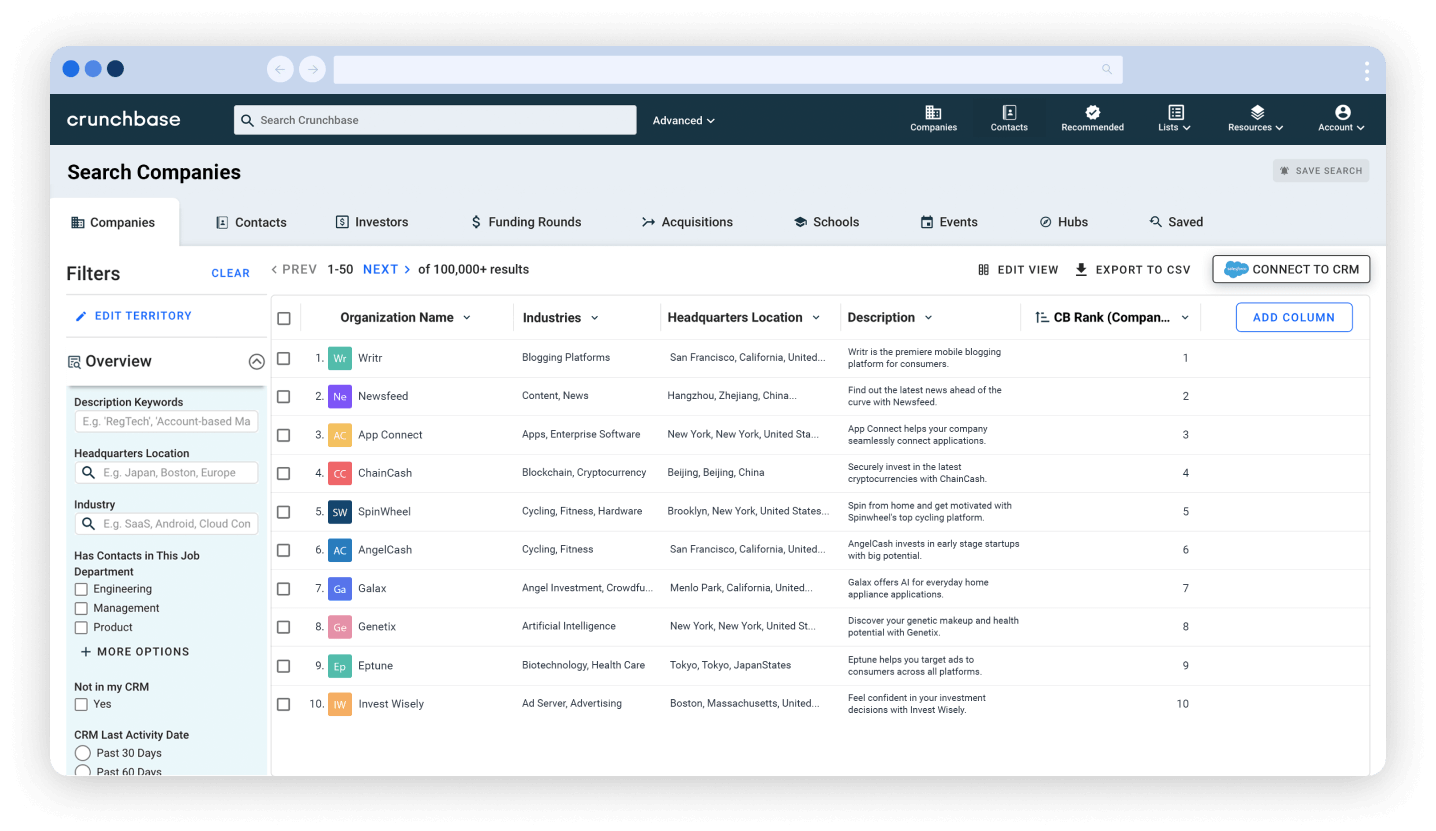Whether you’re new to the sales world or a seasoned sales development representative, effective sales prospecting is fundamental to your professional success. You’ll need to have a strong understanding of how to create a fail-proof prospecting strategy, from finding high-quality prospects to reaching out and moving them down the funnel.
In this guide, you’ll learn everything you need to know about sales prospecting along with techniques, tools and best practices to help you succeed. You’ll get step-by-step, actionable recommendations and tips so you can start filling your pipeline right away.
What is sales prospecting?
Sales prospecting is the act of identifying and contacting potential customers (also known as prospects) for your business. The goal of prospecting is to determine who is a good fit for your company’s products or services so you can guide them down the sales funnel.
Typically, sales prospectors hold sales development representative or business development representative roles. They focus on identifying prospects and building their sales pipeline, while account executives spend their time nurturing these prospects and closing deals.


Why is sales prospecting important?
As you might expect, sales prospecting is the first step in the sales process.
It’s a vital part of your sales strategy because it helps you fill your sales pipeline, which brings you one step closer to closing deals and securing new customers.
Sales prospecting is also important because it allows you to connect and engage with potential customers. This carries heavy weight, since you’ll want to communicate with customers in a way that builds trust and aligns with your brand’s values.
On top of that, prospecting gives you valuable insight into your potential customers’ pain points. You’ll learn about your target audience at a deep level by interacting with them directly, and you’ll also become a master at positioning your product as a solution to their needs. When you find good-fit prospects who have a genuine need for your offering, you increase your likelihood of closing the deal – and avoid wasting time on those unlikely to buy.
Free sales prospecting guide
Get your free sales prospecting eBook when you fill out this form
Sales prospects vs leads
At the early stages of the marketing and sales process, sales prospects are often confused with leads.
Both terms refer to people early in the funnel who are not yet customers, but there are some important differences between prospects versus leads:
- Leads are people who’ve expressed an interest in your brand. They may have visited your website, subscribed to your newsletter, commented on a social media post or engaged with other marketing materials. These people may or may not be a good fit for your business.
- Prospects are leads that you or your team have qualified. For example, a qualified prospect may be someone who fits your company’s ideal customer profile based on factors like their industry, company size and company funding. A prospect may also be someone who’s taken steps on your website that indicate an initial level of commitment to moving down the sales funnel, like signing up for a free trial. Different companies have different indicators for what qualifies a lead as a prospect.
As a salesperson, you’re going to encounter both leads and prospects. The end goal with both, of course, is to ultimately convince them to buy. The reason to focus on prospects, though, is that it’s a more efficient use of your time. When you prospect — that is, when you build a robust list of prospective customers and systematically reach out to them — you focus on communicating with people who you know are a good fit for your business. That means more pipeline and, ideally, more sales.
Inbound vs outbound sales prospecting
Next, we’re going to dive into how to prospect for sales, as well as some sales prospecting tips and techniques you can try. But before we get into that, you’ll need to know the difference between two types of prospecting: inbound versus outbound.
- Outbound sales prospecting involves proactively contacting potential customers to tell them about your product or service. This includes reaching out to customers via cold calls, cold emails, LinkedIn InMail messages, or even in-person at networking events and conferences.
- Inbound sales prospecting involves sharing content that entices potential customers to visit your website or interact with you on other channels. In some cases, these prospects may reach out to book a demo or meeting on their own. Inbound prospecting also involves sending warm emails (emails to those who’ve already indicated interest in your product) or responding to messages and comments over social media.
While different companies take different approaches based on their industry and target audience, most sales prospecting involves a healthy mix of inbound and outbound strategies.
How to prospect for sales in 6 steps
- Find and research prospects
- Qualify your prospects
- Prioritize your prospects
- Reach out with a personalized message
- Schedule a meeting or call
- Close the deal
Now that you have some background on what sales prospecting involves, let’s go over the steps you should take to prospect effectively. No matter your level of experience, use these step-by-step instructions to navigate the entire sales prospecting process as efficiently as possible.
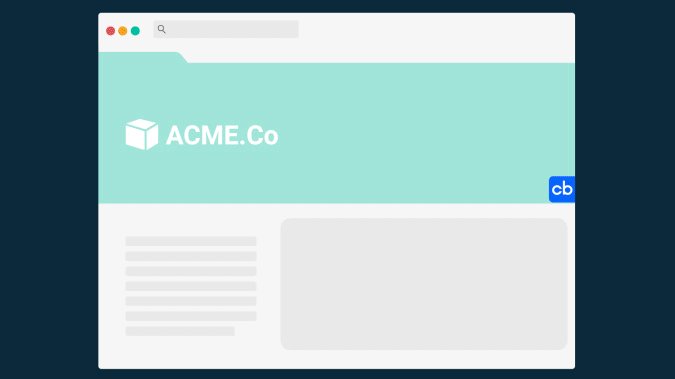

1. Find and research prospects
As a salesperson, you don’t want to add just anyone to your prospecting lists. Imagine trying to pitch a new burger joint to vegetarians or a beginner’s running shoe to pro athletes. These people won’t ever become customers, and you’ll be wasting your time.
Instead, you’ll need to find prospects that fit your ICP, which is the type of customer that would benefit most from your product or service. Your ideal customers likely fit certain criteria – perhaps they’re midsize SaaS companies based in the U.S. – and you can use these criteria to narrow down your search.
So, where do you start looking? Some of the most popular places include:
- Crunchbase: Crunchbase is a prospecting tool with advanced search filters and a robust dataset that makes it easy to find the companies you’re looking for. The platform includes information like company firmographics ((think industry, location and headcount), funding data (because companies that have more money can spend more money), contact information, acquisitions data and other company news. Its advanced search filters let you build queries – and get as granular as you want – to find prospects that match your ICP. As one user notes, “Crunchbase eliminates searching for a needle in a haystack, helping us block out the noise and go after the companies that matter.”
- LinkedIn: LinkedIn is another place to find prospects. You can type an industry into the search bar to browse companies within your territory, join LinkedIn Groups that are relevant to your target audience, or look at job postings to get a better understanding of a company’s priorities. While you won’t necessarily find contact information here, it’s a helpful place to network with potential customers.
- Social media: Posts on Twitter and other social channels can reveal a company’s pain points as well as recent successes like acquisitions or new funding. You can create a list of 3-4 keywords that are relevant to your prospects, and then type those into the search bar to get a sense of companies that might need your solution.
- Industry blogs, newsletters and business journals: These are all sources of industry updates and news that you should regularly keep an eye on. Do a quick search of online magazines and blogs within your target market and subscribe. This is a great way to familiarize yourself with industry trends and learn about growing companies that fit your ICP.
As you do your research, another factor to keep in mind is that account-based prospecting tends to be the most efficient method. This means you’ll want to identify high-value companies first, and then personalize your sales strategy for each one. This contrasts with the traditional lead-based approach, which involves reaching out to as many people as possible (regardless of whether they’re qualified). When you start the prospecting process by identifying qualified accounts first, you increase your likelihood of getting good-fit customers, bigger deals and higher win rates.
Crunchbase ROI Calculator
See the number of new accounts Crunchbase can add to your funnel with our advanced prospecting ROI calculator powered by Crunchbase data.
- -
- -
- -
- $-
2. Qualify your prospects
More prospects doesn’t necessarily mean better. As we mentioned, filling your pipeline with unqualified prospects will cause you to waste your time reaching out to the wrong people.
In order to decide whether a prospect is worth your time, ask yourself the following questions:
- Does the prospect closely match my ICP?
- Do they have the resources to buy my product?
- Has the company recently raised funding?
- Is the company actively hiring, rather than conducting layoffs?
- Do they have a need for my product?
- Have they shown an interest in learning more about my product?
- Are they unhappy with their current product or service?
- Do they have a reason to buy my product immediately or in the near future?
- Do I already have a connection with a decision-maker at their company?
If the answer to several of these questions is “no,” you’ll want to disqualify the prospect and remove them from your list. Even if they fit your buyer persona, they aren’t worth spending time on if they aren’t experiencing relevant pain points or don’t have money to spend. Remember, the quality of your leads is more important than the quantity.
Pro Tip: You can speed up the research and qualification process with automated suggestions from Crunchbase that fit your ICP. Based on your territory preferences and behavior, Crunchbase will automatically surface qualified prospects for you. Take a look at Crunchbase’s similar companies and recommendations features to learn more.
3. Prioritize and score your prospects
One of the biggest challenges of prospecting is meeting your monthly quota. That’s why, once you compile a list of qualified prospects, you need to prioritize the ones that are most likely to buy.
Rather than relying on guesswork, you can organize your prospects in order of priority by assigning them a score. A lead score is a quick calculation based on the factors most important to your company – for example, deal size and timing. The most crucial factors (that is, the factors that will drive the most revenue) get the most weight in the calculation. By reaching out to the top-scored leads first, you increase your chances of making sales, closing bigger deals and meeting quota.
It’s worth noting that you won’t necessarily have an explicit conversation with your prospect about factors like their budget, timing or needs, especially if you haven’t connected with them yet. Still, you can use certain indicators to understand where they stand.
Trigger events and buy signals, such as new funding, are effective indicators because they make it clear when a prospect has extra money in the bank. Likewise, a new CTO hire may be a sign that a company is looking to revamp their tech stack. Finally, looking into a company’s existing tech stack helps you identify which companies are using your competitors and which ones may have a need for your solution.
Pro Tip: Use Crunchbase to find data about your prospects’ funding, leadership hires and tech stacks, and set up notifications for when buy signals happen. Paying attention to buy signals will ensure you act on the most relevant prospects right away. Here’s a list of companies funded within the past 90 days that you can use to start your search.
4. Reach out with a personalized message
When you continually add to your list of qualified prospects, you build a strong foundation for the rest of your sales prospecting process. The next steps are to engage with those prospects, educate them about your product and convince them to buy.
Begin your outreach by making sure you have the contact information for key decision-makers at your target accounts. You’ll want to talk to someone who has a clear idea of the company’s strategy and direction, as well as a good deal of control over it. Speaking to an employee who doesn’t have any real purchasing authority will prolong your overall sales process.
Pro Tip: You can find the verified contact information of key decision-makers, including their email addresses and phone numbers, on Crunchbase. Try it now.
Next, determine which channels of communication you want to use. Both email and phone are popular choices. Create a schedule to determine your day-to-day sales cadence so you can steadily build pipeline throughout the month. That way, you know exactly how many emails or calls you need to make each day in order to hit your sales goals.
And remember, just because you take that first email or call off your to-do list doesn’t mean the outreach is over. Studies show that 80% of sales reps require five follow-up calls after the meeting, but 44% of sales reps give up after just one follow up. It’s understandable that you don’t want to come across as pushy or aggressive, but challenge yourself to be persistent and follow up at least five times.
Regardless of how and when you choose to reach out, you’ll need to craft a personalized message based on prior research of your prospects. Read about prospecting email templates and tips for more details on creating the perfect outreach email.
I always have Crunchbase open on my computer, and I use it several times per day to quickly find and connect with qualified prospects. I can easily search and create lists based on my clients’ criteria, and then personalize my outreach based on the information I learned in Crunchbase. It’s a resource I couldn’t go without!
Jake Hampson, Founder, Sales on Demand
5. Schedule a meeting or call
Did your outreach generate interest? Great! Now, it’s time to schedule a meeting with the interested prospect.
This meeting can take place as a phone or video call, or even in person. Either way, you’ll need to deliver a persuasive sales pitch.
During your first call, you’ll give your sales pitch and build interest in your product. This will be a discovery call where you host a demo, discuss the prospect’s pain points and explore how your product can help them. You should prepare for these meetings by doing thorough research of your prospect first. Learn about your contact’s professional role, trends in their industry and recent challenges and successes at their company.
Depending on the length of your sales cycle, you may also find yourself holding additional educational meetings. This series of meetings will help you better understand your prospect’s specific needs so you can tailor your pitch accordingly. Keep in mind that throughout this process, it’s crucial that you educate rather than sell. You want to sound helpful, not pushy.
This is also the point in the sales process where you’ll be handling objections. Often, objections relate to price, need or timing. To prepare for these objections, work with your team to craft an objection management document, which should list the top 25 objections you face and a 2-3 sentence response to each. Be sure to practice these responses before going into your prospecting calls.
Finally, don’t forget to keep the lines of communication open even after the meeting. At the end of every meeting, align with your prospect on when to schedule the next call. After the meeting, immediately follow up with them to summarize what you discussed and outline the next steps. This will keep the conversation moving and steadily bring your prospect to the final stage of the prospecting process: closing the deal.


6. Close the deal
The end goal, of course, is to close the deal. But how do you move your prospect from the meeting stage to the buying stage?
Once you feel you’ve answered all the prospect’s questions and thoroughly educated them about your product, take the final step and ask for the sale. Make a powerful statement, and briefly reiterate what they’ll gain from your solution. You want to go into this question with confidence.
If their answer is “yes,” finalize the paperwork with the customer and set up next steps. Make sure you or a colleague continues to check in with the customer after the sale to help them set up your product and ensure that everything is going smoothly.
If their answer is “no,” save a record of your conversation history so you can follow up in the future, and keep them on your company’s marketing list so they continue to see targeted campaigns. It’s also a good idea to follow up with a quick email to thank them for their time and let them know you’re there if they need anything in the future. You can even ask them to provide feedback about their experience, which will help you maintain a rapport and give you the opportunity to learn from the process for next time.
Sales prospecting tips and techniques
- Get to know your ICP
- Automate account discovery and qualification
- Set effective sales quotas
- Take an account-based approach
- Act quickly on inbound leads
- Ask for referrals
- Become an expert on your prospects and your product
- Try social prospecting
As you’re going through the steps above, there are a few sales prospecting techniques you’ll want to implement to strengthen your chances of closing the deal. These will help you go after the right prospects, stay on task to meet quota and make your pipeline as airtight as possible.
1. Get to know your ICP
We already talked about how important it is to go after accounts that fit your ideal customer profile. Companies that fit your ICP are most likely to buy and continue to use your product, making them extremely important for business growth.
Jot down a definition of your ICP based on firmographic qualities like funding or IPO status, company size, revenue, industry and location. You can even go narrower by adding characteristics like recent leadership hires or the current tools they use. Base the qualities you select on the shared characteristics of your existing customers. This will show you what your “perfect” customer looks like – and who you should be targeting in your prospecting efforts.
Once you’ve outlined your ICP, you can use it to find new prospects and qualify existing leads. If your company hasn’t already defined your ICP, here’s how to create your ideal customer profile from start to finish.
2. Automate account discovery and qualification
Ironically, the average sales rep spends only 36% of their time actually selling. Between digging up the right prospects, sifting through tabs to find their contact information and manually entering data into your CRM, your day-to-day tasks can easily take a good deal of time. Unfortunately, the more time you spend on these tasks, the less time you have to actually reach out to prospects and close deals.
One trick to focus more on selling is to automate tasks that are tedious and repetitive. There are several tools to help you do this. In fact, Shama Hyder, CEO of Zen Media and a LinkedIn Top Voice in marketing, recently experimented with the ChatGPT extension on Google Sheets to discover new companies, list their CEOs, and write an outreach message to each of them.
The tool we recommend for automated sales prospecting is Crunchbase. That’s because Crunchbase has:
- Advanced search filters (including firmographic data, funding information, hiring data and more) so you can find qualified companies and contacts right away
- A built-in recommendation engine that automatically shows you additional prospects that fit your ICP
- A machine learning feature that automatically surfaces companies that resemble your closed deals
- A built-in “push to CRM” button so you can directly push companies and contacts from Crunchbase directly to HubSpot or Salesforce
- Automatic alerts so you can track prospects and reach out at the right time
- Suggested email text that uses Crunchbase data to personalize your outreach messages
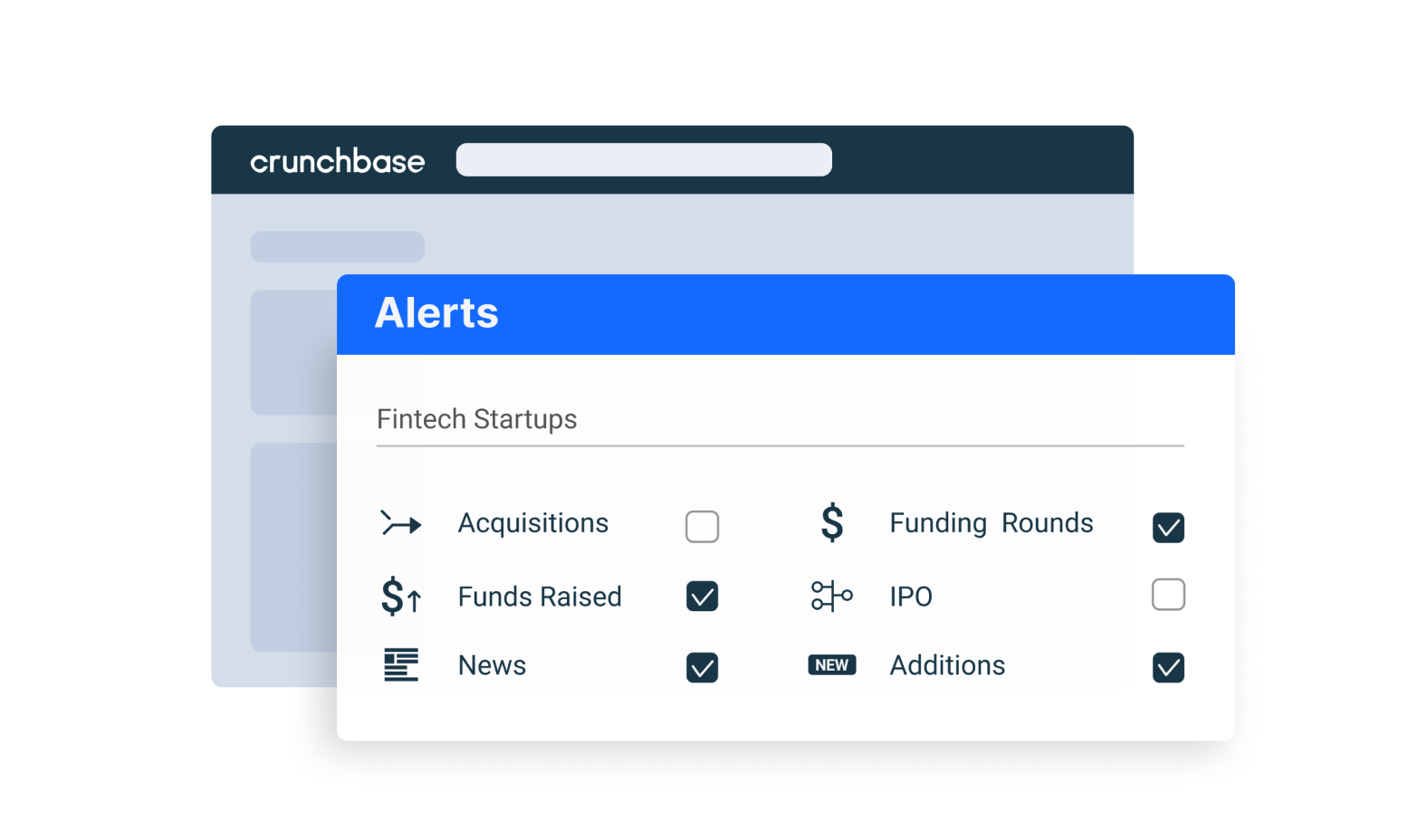

Read more about how sales prospecting tools can help speed up your workflow.
3. Set effective sales quotas
If you’re a sales team lead, you’ll want to set ambitious but attainable sales quotas.
Create a quota for your entire sales team, including individual sales quotas for each team member. Sales quotas can vary in length of time, so having a broader annual quota made up of weekly, monthly and quarterly quotas will help your team stay on track.
Some sales leaders prefer a top-down approach to creating a sales quota. This involves starting with your monthly sales team goal and then dividing that number by the number of people on your sales team, distributing quota evenly among team members.
Other sales leaders prefer a bottom-up approach to setting sales goals. This approach uses historical performance data and ramp status to determine individual quotas for each team member. From there, the quotas are combined to create an overall metric for your team. Whichever approach you choose, you’ll want your team’s goals to add up to your company’s revenue objectives.
4. Take an account-based approach
In our earlier discussion of how to find prospects, we emphasized the importance of account-based selling, or the act of concentrating your efforts on your highest-priority prospects rather than reaching out to as many leads as possible.
While traditional prospecting techniques like making cold calls and sending email blasts are still the go-to strategies for many salespeople, the yield is often low, and you run the risk of your messages being sent immediately to the trash or spam. Leveraging an account-based approach, on the other hand, involves sending personalized messages to the key decision-makers at your most important accounts – a tactic that often proves more successful. In fact, some companies have experienced a 171% increase in annual contract value after making the switch to an account-based strategy.
Here’s a quick demo that walks through how Crunchbase can help you easily find and connect with contacts at accounts that match your ICP:
5. Act quickly on inbound leads
As a salesperson, you can work with your company’s marketing team to develop effective inbound strategies that generate interest and that push marketing qualified leads into your court. These may include online ads, social posts, webinars, downloadable PDFs, landing pages and more. Either way, you’ll want to work cross-functionally to develop a system for following up when a lead interacts with these touchpoints.
FFor instance, your company’s marketing assets could link to a contact form on your site that encourages leads to reach out. From there, you could quickly respond with a phone call, email or even social media message to the lead. According to research by Harvard Business Review, companies that follow up within an hour of receiving an inquiry are “nearly seven times more likely to qualify a lead.”
This is all to say that you should hold regular discussions with your marketing team to better understand your company’s inbound lead generation process – and to brainstorm the types of content that will draw them in.
6. Ask for referrals
Research shows that 66% of salespeople say referrals from existing customers offer the highest quality leads. With that in mind, be sure to ask customers for referrals after you close the deal. Follow up with them and politely inquire whether they know anyone else who would benefit from your product or service.
Another great resource for referrals are your investors. Chances are they’ll be happy to refer you to a good-fit lead within their portfolio if it will be mutually beneficial in driving company growth. After all, they want all the companies in their portfolio to succeed. If you find that a company within your investor’s portfolio would be a great prospective customer, reach out to your investor to ask for an introduction.
Pro Tip: To reach out to an investor, look up their information on Crunchbase. You’ll get their contact details as well as a full list of the other companies they’ve invested in. Get started with investor research here.
7. Become an expert on your prospects and your product
We can’t stress enough how essential it is to research your potential customers before reaching out. A discussion that feels personal and empathetic is infinitely more powerful than a cookie-cutter approach.
Show your prospects that you care by taking the time and effort to get to know them. This may make the prospecting phase more time-consuming, but it ultimately has the potential to help you close deals faster.
A few ways you can get to know your prospects are by:
- Perusing their Crunchbase profile to find relevant information
- Following them on social media
- Subscribing to their blog
- Looking for their content on platforms like YouTube or Medium
- Browsing industry forums and other online communities
- Setting up alerts for key events, like funding, acquisitions and leadership hires
Likewise, you should get to know the ins and outs of your product and its various value propositions, since you’ll want to tailor your messaging for each prospect, answer their questions and offer powerful responses to any objections. Ideally, your company should have a resource bank with information about your product that you can study closely. Combine deep knowledge of your prospect with deep knowledge of your product, and you’ll have a strong foundation for every sales conversation.
8. Try social prospecting
Social prospecting is the use of social media to engage with prospects. This is a newer type of outreach that often feels warmer than cold emails or calls. There are several creative prospecting approaches you can try here, including:
- Sending direct messages to qualified leads
- Reaching out with personalized video content (a tactic called video prospecting)
- Responding to their posts with helpful guidance that points them toward your product
- Posting informative, inspiring content and engaging with them in the comments section
There’s no single right way to go about this – just be sure to come across as genuinely insightful rather than spammy. If you’re part of a B2C sales team, you’ll likely generate more engagement with Instagram or Twitter. B2B sales prospecting, on the other hand, yields better results on LinkedIn, since the platform is oriented toward companies and professional life. Whichever channels of communication you choose, this prospecting technique is a great way to turn your company’s existing customer-facing platforms into a relationship-building and revenue generation tool.
The sales prospecting process
At this point, you’ve gotten a comprehensive overview of how sales prospecting works and the different techniques you should try. Now, let’s take a quick look at how prospecting fits into the various stages of the sales process.
The sales process is typically broken down into seven stages, which can be summarized like this:
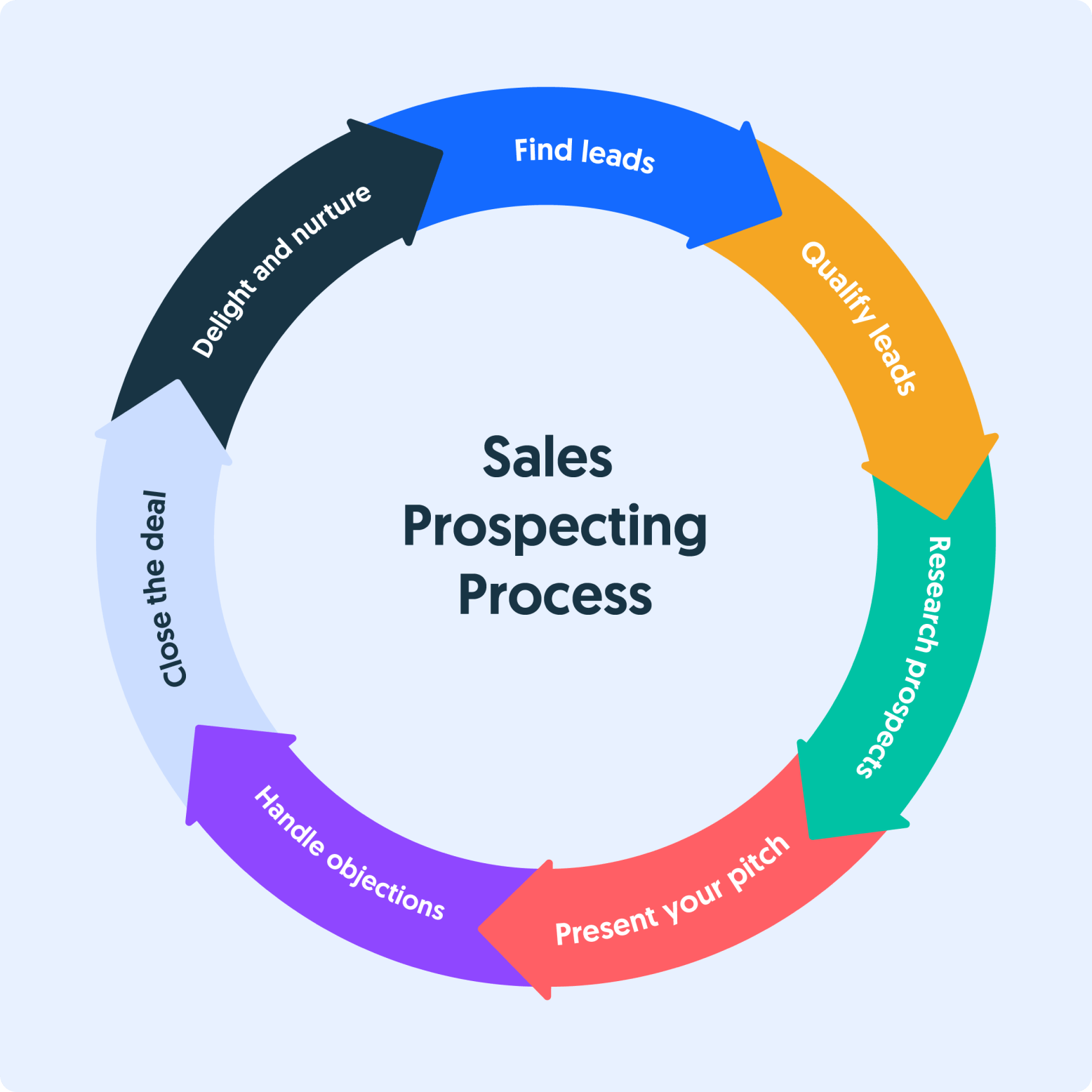

Stage 1: Find leads
This is where prospecting – and the sales process as a whole – begins. Identify leads through online research via tools like Crunchbase, or even in-person at conferences and industry events.
Stage 2: Qualify leads
Qualify your leads to determine which ones are worth going after. You can do this by using company data and news to determine whether they fit your ICP. If a lead agrees to a phone call, you can directly ask them qualifying questions about their role, pain points and preferred solutions. Once you qualify leads, they become known as “prospects.”
Stage 3: Research prospects
At this stage, you already have some insight into your prospects, either based on online research or a quick call. Still, you’ll need to prepare your pitch by researching them even more thoroughly. This is where the prospecting tactics we mentioned earlier, like subscribing to a company’s blog and following them on social media, come in handy.
Stage 4: Present your pitch
When you feel like you’ve properly qualified and thoroughly researched your prospect, it’s time to prepare for the pitch. Set up a sales presentation, meeting or call in which you pitch your product and discuss how it can help the prospective customer achieve their goals.
At many companies, this is where the prospecting phase ends and the selling phase begins. Often, SDRs and BDRs are in charge of identifying prospects as opportunities, and then they pass these opportunities off to account executives to run product demos and pitches. If you’re selling B2B software or have a more technical product, presales professionals like sales engineers or solutions engineers may also join the demo.
Stage 5: Handle objections
Objection handling is the next stage in the sales cycle in which account executives and any others involved in the sale answer questions, alleviate concerns and ultimately help the prospective buyer overcome their hesitations and move onward to the next stage. When you engage with potential buyers and deal with their objections head-on, it builds trust and results in a higher chance of closing the deal.
Stage 6: Close the deal
The pitch is done, the objections are handled — now it’s time to seal the deal. Answer any final questions and confirm with the prospect that they’re ready to make a purchase. Depending on the person or company, you may want to either take a direct approach and simply ask if they’re ready to sign or take a softer approach, such as by summarizing your product’s benefits and gently asking if they’re onboard.
Stage 7: Delight and nurture
Creating a relationship with a buyer and then cutting them out of communication to fend for themselves is the easiest way to get terrible reviews and lose customers as quickly as you’ve earned them. That’s why, contrary to what you might think, closing the deal is not the last stage in the sales cycle.
To ensure your new customers start happy and stay happy, be sure to keep many lines of communication open. For large enterprise deals, pass your new customer on to a dedicated implementation consultant or customer success manager who can help onboard and answer any questions they may have. This is also the time to ask the new customer for any referrals they might be willing to give.
You can also keep these customers on your radar for future cross-sell and upsell opportunities. For example, you may try to sell them add-ons or offer them additional seats at a later stage.
Top sales prospecting tools
As you go through the sales prospecting process, you’ll find there are loads of prospecting tools out there to help you do your job effectively. Here are some of our favorites:
1. Crunchbase
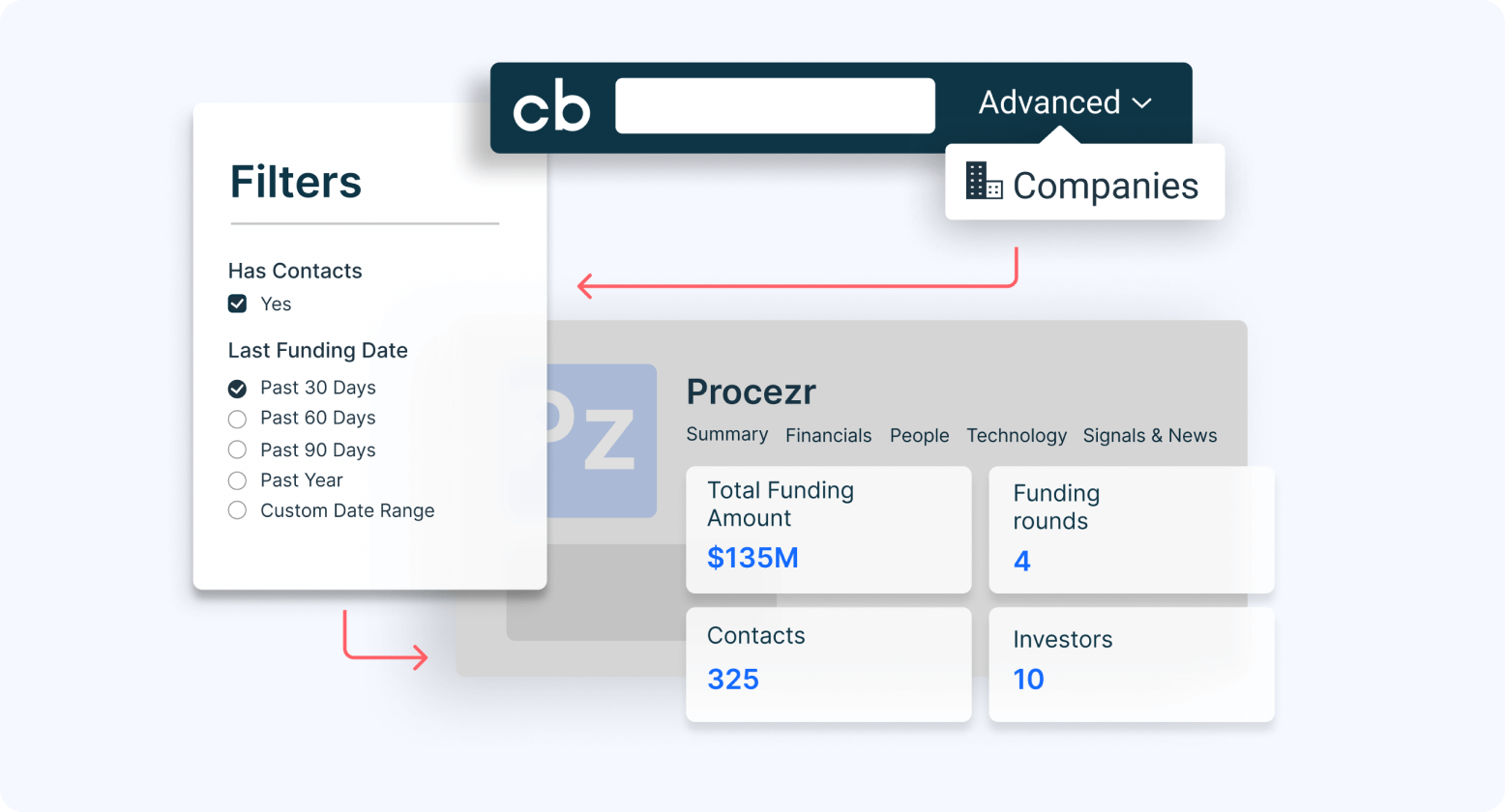

Best for: All-in-one prospecting
Why it’s popular: Crunchbase is a prospecting tool that helps you find and close deals faster. The platform includes best-in-class firmographic and funding data, as well as verified contact details for key decision-makers, so you can discover, qualify and reach out to companies in your territory. It also helps you build pipeline faster by surfacing relevant account recommendations and notifying you of key buy signals so you know exactly when to reach out. Another bonus is that it’s an all-in-one prospecting platform, meaning you can reduce your tech stack and keep your entire prospecting workflow in the same place.
Using Crunchbase has saved me at least 2 hours a day, honestly. I used to spend so much time copying, pasting, searching, going back, and tracking all this data manually to find the best fit companies for our services. Now, having Crunchbase and the Chrome Extension is like flying! It has everything you need in just a few clicks.
Pavel Topalov, Associate Sales Development Representative, Lokalise
2. Gong
Best for: Sales enablement
Why it’s popular: Gong.io offers a sales conversation intelligence platform designed to improve calls and demos for sales teams. The cloud-based tool uses artificial intelligence to automatically record, transcribe and analyze every sales conversation and call, helping teams evaluate their performance and continually improve their outreach.
3. Dialpad
Best for: Sales enablement
Why it’s popular: Dialpad is a cloud-based business phone system that turns conversations into opportunities and helps teams make more strategic calls. It transcribes sales calls real-time, analyzes customer sentiment, offers live outbound sales coaching and more.
4. HubSpot
Best for: Customer relationship management
Why it’s popular: HubSpot offers a free CRM software that’s easy to use and great for small businesses. This gives you detailed reports on sales team activity, productivity and individual performance so you can help your team develop and succeed. As an added bonus, you can integrate your HubSpot CRM with Crunchbase and push company and contact data straight from Crunchbase to HubSpot – no manual data entry required.
5. Salesforce
Best for: Customer relationship management
Why it’s popular: Salesforce is a global cloud computing company that provides business software on a subscription basis. Its CRM solution is widely considered the number one CRM platform in the world. And, with Crunchbase’s Salesforce integration, you can sync the accounts you discover in Crunchbase directly to Salesforce. Just as with the HubSpot CRM, push company and contact data from Crunchbase to Salesforce in seconds.
6. PandaDoc
Best for: Deal management
Why it’s popular: PandaDoc is a tool that helps you eliminate the tedious paperwork involved in closing deals. Sales teams use this tool to build, share and electronically sign proposals, quotes and contracts.
7. Cirrus Insight
Best for: Deal management
Why it’s popular: Cirrus Insight helps reduce CRM friction among your sales team. It includes automated tools that help reps manage their sales cadence, send personalized outreach emails and more.
8. Emissary
Best for: Sales networking
Why it’s popular: Emissary pairs sales professionals with industry leaders, including former executives at companies they are targeting. This helps you build strong professional relationships and get actionable guidance for closing deals.
The tools above facilitate every part of the sales prospecting process, from account discovery and qualification to outreach and deal management. Now, we’re going to hone in on the part of the process that is arguably the most critical, but also the most daunting: outreach.
Prospecting email examples and templates
You’ve probably heard that you have only one chance to make a good first impression, and that carries extra weight when it comes to sales. How do you even begin making contact with your prospects? What channels should you use? And what goes into crafting the perfect first touch?
First, both cold emails and cold calls are legitimate, effective methods of outreach, and different prospects prefer different channels. That said, 80% of people prefer sales reps to contact them over email, largely because it’s less intrusive and doesn’t force them to have a conversation on the spot. Cold emails can also save you time as a salesperson, since they’re easy to tweak and scale once you have the right templates.
Here are some examples of cold emails you can leverage in your outreach. Feel free to use these as templates and customize them for your prospects.
1. Attention-grabbing prospecting email
Why it works: Seize your prospect’s attention with a personalized statement or question. Then explain the value of your product or service, build their interest and clearly state the next steps for moving forward with the deal.
Hi [prospect name],
Could your team use more [highlight a key result of using your product]?
[Product name] will help you hit your goals by:
● [Benefit #1]
● [Benefit #2]
● [Benefit #3]
In fact, three of our customers just had great results using [product name] for [what your product helps achieve].
If you want to learn more, let’s have a conversation. Are you free for a quick call at [specific day and time]?
Cheers,
[your name]
2. Congratulatory prospecting email
Why it works: Show your prospect you’ve done your research with a hyper-personalized email, and build a rapport by congratulating them on recent events. Then, introduce yourself and offer to connect over a call.
Hi [prospect name],
Congratulations on your $50M Series B! I’m a big fan of your company’s [product/feature/mission], and I’m excited to follow your growth.
By way of introduction, I’m [your name], [your job title] at [your company name]. I work with businesses like yours to achieve [specify results of using your product]. Just last week, we had a customer tell us that [what your product helped them achieve].
I’d love to connect to see how I can help you meet your goals as your company grows. Are you free for a quick chat at [specific day and time]?
Cheers,
[your name]
3. Free resource prospecting email
Why it works: Everyone loves free stuff, and offering a free educational resource shows that you genuinely care about serving your customers, not just selling your solution. If you put time, care and thought into talking to your prospects, they’ll be more likely to do the same with you.
Hi [prospect name],
We know that [what your product helps achieve] is at the top of your team’s priority list. So we created a free resource to help.
This free [name of resource] will show you:
● [Main takeaway #1]
● [Main takeaway #2]
● [Main takeaway #3]
Give it a read and let us know how you liked it! In the meantime, are there any other ways we can help your team with [specify pain point]? I’m happy to jump on a call at [specific day and time] to walk through it with you.
Talk soon,
[rep name]
As you can see, there are lots of different angles you can take when reaching out to prospects. Regardless of your approach, keep these points in mind:
- Use a punchy and concise opening line
- Personalize the email based on the prospect’s industry, pain points, and notable successes
- Offer help, whether in the form of guidance or a free resource
- Emphasize the benefits of your product, rather than the features
- Share stories of customer successes when possible
- Have a clear call-to-action with next steps
Pro Tip: Crunchbase helps you send emails like these at scale with pre-built templates. These emails are tailored to your prospects using live Crunchbase data, like recent funding or relevant industry news. Learn more here.
Sales prospecting resources to get started
At this point, you have a thorough understanding of what sales prospecting is and how to do it right. Here are a few additional resources so you can start prospecting right away.
- The Crunchbase Unicorn Board is a list of the most valuable private companies in the world. This list is updated in real-time as companies reach unicorn status — giving you instant access to the latest funding information so you know which companies have buying power.
- The Crunchbase Emerging Unicorn Board is a list of global private companies that are on the path to achieving unicorn status. This list is updated in real-time as companies reach a valuation of $500 million or more but less than $1 billion, helping you efficiently track high-growth companies to add to your pipeline.
- This list of fintech companies with a recent leadership hire shows you which companies within the fintech industry are onboarding new decision-makers. This is a buy signal you’ll want to pay attention to since it indicates expansion, a bigger budget and potential interest in new solutions and tools.
- This list of health care companies that raised $10 million-plus in the past year depicts recently funded companies within the healthcare industry. Note that you can adjust this list for different industries and funding amounts to surface companies within your target market that have the resources to buy.
Using these resources and the tips above, you’ll be well-equipped to develop a powerful sales prospecting strategy. While prospecting may seem daunting at first, targeting the right customers, consistently building pipeline and conducting strategic outreach will give you the skills and confidence to succeed.




